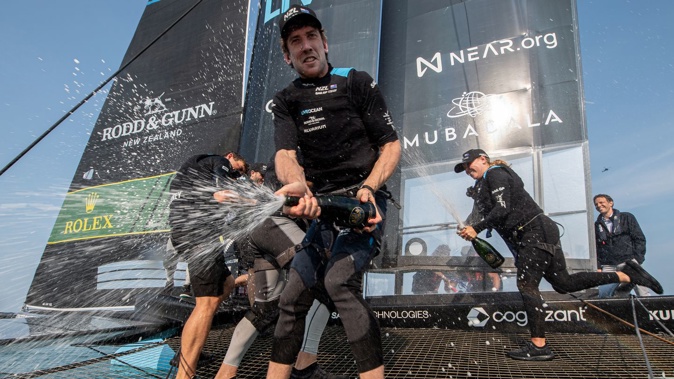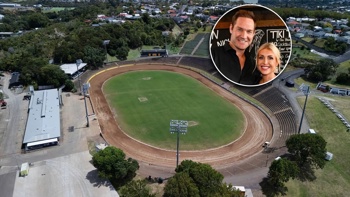
As the New Zealand SailGP team approached the finish line to win the season’s opening event in Chicago this weekend, there was a sense of relief and elation on board.
Edging toward the finish line, the onboard comms of driver Peter Burling summed up Sunday’s racing.
“A hell of a day.”
It was an event of stark contrasts. After a day of the usual high-speed foiling racing seen in SailGP, the wind didn’t show up on Sunday and forced the 10 teams to race in displacement mode with their hulls having no chance of leaving the water.
With the number of sailors onboard dropping to four and the teams sailing with a big 29m wing, some new tactics come into play. Some teams tried to get extra momentum by raising and dropping foil arms to act like something of an oar, while some boats had sailors sitting at the front of the vessel holding the sail out in an attempt to help it catch what little wind there was.
“We actually sort of saw that coming in the forecast from about Thursday and we geared up for that, throughout the weekend,” New Zealand flight controller Andy Maloney - who held the sail on the Kiwi boat at times - told the Herald.
“We preempted it a little bit and did a first run through that sort of configuration on Thursday when we first arrived in Chicago and then parked it for Friday, which was obviously a bit windier, but revisited it this morning. We did see that coming.”
But in a final against Australia and Canada, it was a familiar tactic from the Kiwis that set them up for success.
All weekend, the New Zealand crew had prioritised getting across the starting line on the far left side in order to set themselves up for the fastest route to round the first marker.
It had them well positioned in the final to undercut Canada, who got across the line first but couldn’t get far enough ahead of the Kiwis to beat them to the mark.
Being the first boat around the mark, it was a case of sailing a clean race from there for the New Zealand team. Slow as it was, there was plenty of tension down the final stretch of the shortened four-leg race as the teams split the racecourse – New Zealand and Canada rounding the second marker at the same time, but going in opposite directions, with Australia following Canada in turning left and sailing on the side where a helicopter was operating, which Maloney said does generate enough of a wind puff to impact the boats.
The Australians made some small gains on the Kiwis, and it came down to who had the best angle to the gate. It was the Kiwis who got there just ahead of their rivals, slamming the door in the face of the Australians and coasting along to claim their first event win of the season.
“There was definitely a brief moment there where we thought we might have given it away, but we had to back ourselves and commit to the side we’d chosen a bit earlier on down the run and luckily we just managed to get the cross in at the top mark just before the finish.”
It was the end to a solid weekend’s racing for the Kiwi team, who put themselves in a strong position on Saturday’s three fleet races, only needing to avoid total disaster in Sunday’s two 10-boat affairs to confirm their spot in the three-boat podium race.
Finishing those two races in third and sixth got the first job done, and they got the result that counted.
It is the perfect way to kick off the new campaign, laying down the challenge to the rest of the fleet after falling agonisingly short of winning the championship – and the US$1 million that comes with it - last season.
Take your Radio, Podcasts and Music with you









